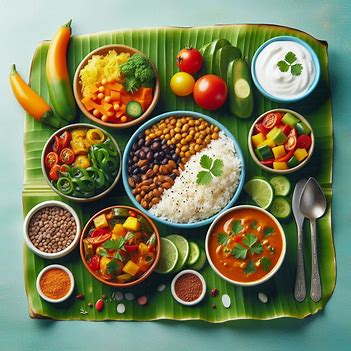Meal Plans
Diabetes-Friendly Indian Meal Plan

Diabetes-Friendly Indian Meal Plan focuses on managing blood sugar levels by incorporating foods with a low glycemic index (GI), balancing carbohydrates, proteins, and healthy fats, and prioritizing portion control. Indian cuisine offers many diabetes-friendly options that can be adapted for those managing blood sugar levels. Here’s a detailed discussion of the components, tips, and a sample meal plan:
Key Principles of a Diabetes-Friendly Meal Plan
- Low Glycemic Index (GI) Foods:
- Low GI foods help control blood sugar levels by releasing glucose slowly into the bloodstream. Examples include whole grains (brown rice, millet, quinoa), legumes (chickpeas, lentils, kidney beans), and non-starchy vegetables (spinach, okra, broccoli).
- Portion Control:
- Even healthy carbohydrates can spike blood sugar if consumed in large quantities. It’s essential to eat balanced portions of grains, vegetables, and proteins.
- Fiber-Rich Foods:
- Fiber slows down digestion, preventing rapid spikes in blood sugar. High-fiber foods like lentils, beans, and whole grains are staples in Indian diets.
- Healthy Fats:
- Include sources of healthy fats, such as nuts, seeds, avocado, and small amounts of ghee or olive oil. Avoid saturated and trans fats which can increase the risk of heart disease, a common complication for diabetics.
- Balanced Macros:
- Combine carbohydrates with protein and healthy fats to reduce the glycemic load of meals. For example, pairing chapati (carbs) with dal (protein) and vegetables (fiber) keeps blood sugar levels stable.
- Spices and Herbs:
- Indian cuisine’s spices like turmeric, fenugreek, cinnamon, and ginger have anti-inflammatory and blood sugar-regulating properties, making them great for managing diabetes.
Foods to Include
- Whole Grains: Brown rice, barley, quinoa, oats, buckwheat, and millet (bajra, jowar, ragi).
- Legumes: Chickpeas, lentils, black-eyed peas, kidney beans, and moong dal.
- Vegetables: Non-starchy vegetables like spinach, kale, broccoli, cauliflower, zucchini, bell peppers, eggplant, and bitter melon (karela).
- Lean Proteins: Tofu, paneer, low-fat yogurt, lentils, legumes, eggs, and lean cuts of chicken or fish.
- Healthy Fats: Almonds, walnuts, chia seeds, flaxseeds, ghee (in moderation), olive oil, and avocado.
- Dairy Alternatives: Unsweetened almond milk or soy milk as alternatives to cow’s milk.
Foods to Limit or Avoid
- Refined Carbohydrates: White rice, white bread, maida-based products (naan, paratha), and sugary sweets.
- Sugary Beverages: Soda, sweetened fruit juices, and packaged drinks.
- High-Sugar Desserts: Jalebi, gulab jamun, halwa, and ladoo made with high amounts of sugar and refined flour.
- High-GI Fruits: Limit mango, banana, pineapple, and grapes, or consume them in small portions.
Tips for Managing Diabetes with Indian Cuisine
- Replace White Rice: Use brown rice, quinoa, or millets like ragi or bajra instead of white rice, which has a higher glycemic index.
- Portion Control for Grains: Keep grains (such as rice or chapati) to smaller portions. For example, have one small chapati instead of two, or replace half your rice with a portion of cooked lentils or vegetables.
- Incorporate Protein in Every Meal: Combine carbs with protein (like dal, chickpeas, or paneer) and vegetables to slow down digestion and avoid blood sugar spikes.
- Snack Smartly: Opt for high-fiber, low-GI snacks like roasted chickpeas (chana), nuts, seeds, or homemade hummus with veggie sticks.
- Use Spices Beneficial for Blood Sugar Control: Incorporate spices like fenugreek (methi), turmeric, ginger, and cinnamon, which can help regulate blood sugar levels.
- Healthy Cooking Methods: Opt for grilling, steaming, or sautéing over deep-frying. Avoid dishes cooked with excess oil, butter, or ghee.
- Hydration: Drink plenty of water, herbal teas, or unsweetened beverages. Avoid sugary drinks and limit caffeine.
Sample Diabetes-Friendly Indian Meal Plan
Day 1:
- Breakfast:
- Oats upma with vegetables (carrots, peas, bell peppers).
- Low-fat yogurt or a small glass of unsweetened almond milk.
- A few almonds or walnuts.
- Mid-Morning Snack:
- 1 small apple or half a guava.
- Handful of roasted chana (chickpeas).
- Lunch:
- 1 small bajra (millet) roti.
- Palak dal (spinach lentil curry).
- Cucumber-tomato salad with a dash of lemon and olive oil.
- Afternoon Snack:
- Roasted makhana (fox nuts) or a few slices of cucumber with hummus.
- Dinner:
- Grilled fish (like pomfret or salmon) or tofu with a side of stir-fried veggies (spinach, zucchini, and bell peppers).
- 1 small serving of quinoa or brown rice.
Day 2:
- Breakfast:
- Vegetable moong dal chilla (savory pancake made from split yellow lentils) with mint chutney.
- 1 small cup of unsweetened green tea.
- Mid-Morning Snack:
- 1 orange or handful of mixed berries.
- Lunch:
- 1 small jowar (sorghum) roti.
- Chickpea curry (chana masala).
- Vegetable raita (yogurt mixed with grated cucumber, carrots, and mint).
- Afternoon Snack:
- Handful of peanuts or a small boiled egg.
- Dinner:
- Grilled paneer tikka or tofu stir-fry with broccoli, mushrooms, and bell peppers.
- 1 small bowl of brown rice or a small portion of quinoa pulao.
Day 3:
- Breakfast:
- Poha made with flattened rice, curry leaves, turmeric, and peanuts.
- 1 boiled egg or a small glass of unsweetened almond milk.
- Mid-Morning Snack:
- 1 small pear or a handful of mixed nuts.
- Lunch:
- 1 small whole wheat chapati.
- Methi dal (fenugreek leaves cooked with lentils).
- Side of steamed broccoli.
- Afternoon Snack:
- Carrot sticks or sliced cucumber with a dash of chaat masala.
- Dinner:
- Baked or grilled chicken (or tofu) with a side of roasted vegetables.
- 1 small portion of ragi or millet khichdi (a porridge made with millet and lentils).
Conclusion
A Diabetes-Friendly Indian Meal Plan focuses on balanced nutrition with an emphasis on low-GI foods, fiber-rich legumes, and whole grains while minimizing refined carbs and sugars. Managing diabetes with Indian food is not only possible but also flavorful and nutritious, with the use of spices, herbs, and diverse ingredients. Adjust portion sizes, prioritize whole foods, and maintain regular meal timings to stabilize blood sugar levels and enhance overall health.